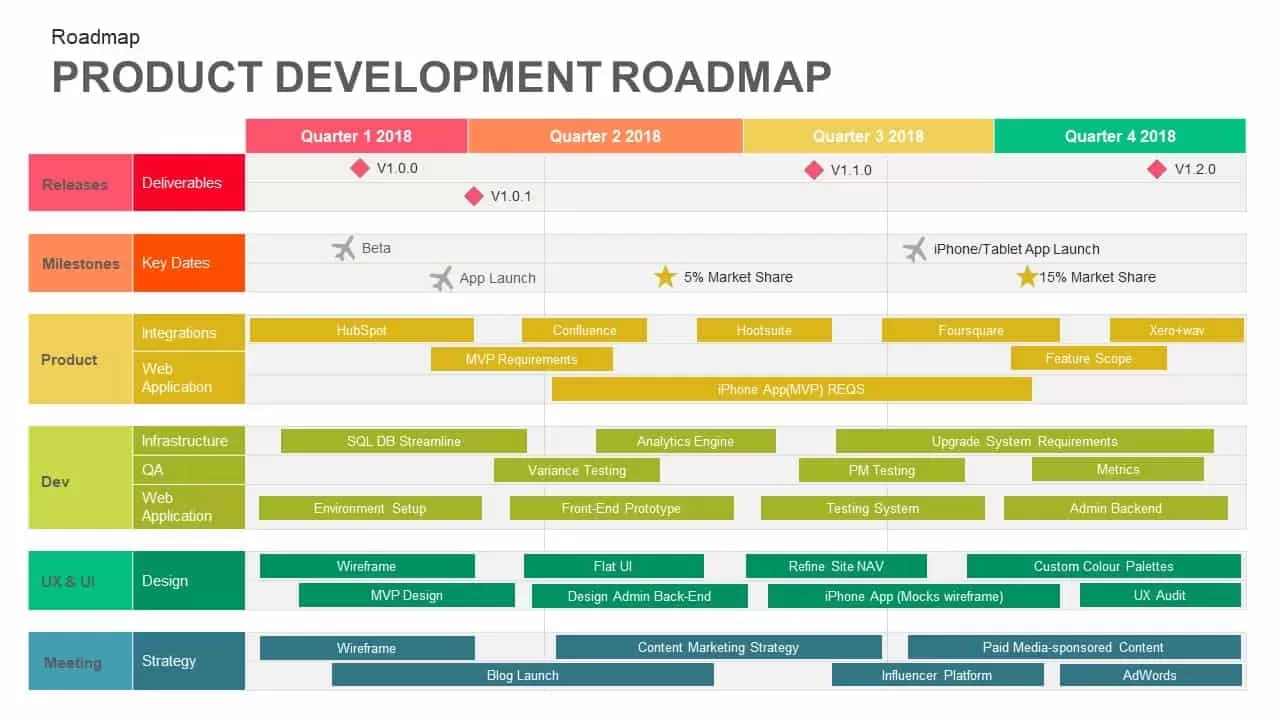Product Development Roadmap
What is the Product Development Roadmap?
Definition:
A Product Development Roadmap is a strategic plan that outlines the stages, milestones, and key activities involved in bringing a product from concept to market. It serves as a visual guide, illustrating the product development process, timelines, and dependencies. The roadmap helps align cross-functional teams, stakeholders, and resources toward a shared vision, fostering effective communication and coordination throughout the product development lifecycle.
Analogy:
Consider a Product Development Roadmap as a detailed itinerary for a cross-country road trip. Much like a roadmap guides travelers through different states and cities, a product development roadmap guides a team through various stages and tasks, ensuring a well-planned and organized journey from product ideation to launch.
Further Description:
Product Development Roadmap involves several crucial components:
Idea Generation and Conceptualization: The roadmap begins with the generation of product ideas and the conceptualization of potential solutions to address market needs or challenges.
Market Research and Validation: Before proceeding, thorough market research is conducted to validate the product concept, identify target audiences, and assess the competitive landscape.
Definition of Requirements: Clearly defining product requirements involves specifying features, functionalities, and technical specifications necessary for development.
Design and Prototyping: The design phase includes creating wireframes, mockups, and prototypes to visualize the product’s user interface and experience before actual development.
Development: This stage involves writing code, building the product, and implementing the design and features outlined in the requirements.
Testing and Quality Assurance: Rigorous testing ensures that the product meets quality standards and is free of bugs or issues.
Deployment: The product is deployed to the intended environment, making it available for use by the target audience.
Marketing and Launch: The launch involves creating marketing strategies, promotions, and campaigns to introduce the product to the market effectively.
Post-Launch Support and Iteration: Continuous monitoring, user feedback analysis, and iterative updates contribute to post-launch support, ensuring the product evolves to meet changing market needs.
Why is the Product Development Roadmap Important?
Clear Communication: A product development roadmap provides a visual and structured plan, facilitating clear communication among team members, stakeholders, and decision-makers.
Resource Planning: It aids in resource allocation by outlining tasks, dependencies, and timelines, allowing teams to plan and allocate resources efficiently.
Risk Mitigation: Identifying potential risks and dependencies in advance enables proactive mitigation strategies, reducing the likelihood of project delays or issues.
Stakeholder Alignment: A roadmap aligns stakeholders with a shared understanding of the product development journey, fostering collaboration and commitment.
Goal Orientation: It keeps the team focused on the overarching goals and objectives, preventing deviations that may derail the project.
Examples and Usage:
Apple iPhone Development: Apple’s product development roadmap for the iPhone involves meticulous planning, from conceptualizing new features to the yearly release of upgraded models.
Software Development Platforms: Companies like Microsoft and Adobe follow product development roadmaps for their software, outlining regular updates, new features, and improvements.
Automotive Industry: Automotive companies use product development roadmaps for designing, testing, and launching new vehicle models, incorporating advanced features and technologies.
Key Takeaways:
- Begin with a solid foundation by generating and validating product ideas before committing resources.
- Clearly define product requirements to guide the development team and set expectations.
- Embrace an iterative process, incorporating feedback and making improvements throughout the development lifecycle.
- Rigorous testing is crucial to ensuring the product meets quality standards and user expectations.
- A well-planned marketing strategy is essential for a successful product launch and market penetration.
- Continuous monitoring, user feedback analysis, and post-launch support contribute to the product’s long-term success.





